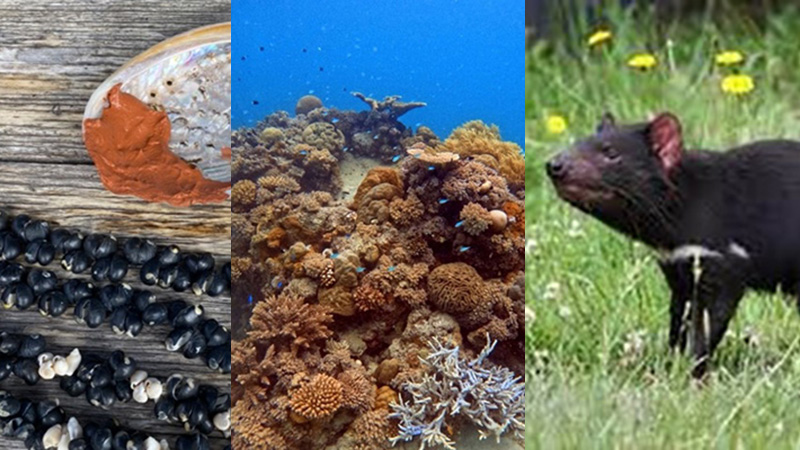
This “storybook” is a culmination of the research each student conducted on a topic related to the theme of the study abroad program Australia – Managing Diverse Ecosystems. During their time in Australia students interviewed people knowledgeable about their topic, collected data, took photos, and made observations. We hope you enjoy reading what the students discovered about Australia and themselves. It was an honor and delight to get to know these awesome students and to share their experience in “The Land Down Under”! - Dr. Mark Burbach & Dr. Jessica Corman, trip leaders.
A Cultural Perspective from a Tasmanian Aboriginal - by Brooke Mott
In Tasmania, some may recount the beginning of their people’s history back to British colonization in the state, but the true history goes back much further to the original people of Tasmania. The aboriginal people were thought to have arrived to the area 30,000 ya, when an ice age lowered the sea levels and made land travel there accessible. During this time 30,000 – 15,000 years ago, the Tasmanian aboriginals were the most southernly people on Earth. Carbon dating has dated the original peoples to have been in Tasmania up to 100,000 ya, and 120,000 ya on the mainland of Australia. They’re considered the original keepers of Tasmania from their close, mutually beneficial relationship with nature, caring for the land around them. The struggles that the Aboriginal people have gone through is bleak at best, but Tasmania is slowly coming to acknowledge, educate, and support this group that has been the foundation for the country they know today.
Follow the rest of the story at: https://snr.unl.edu/undergrad/beyondclassroom/studyabroad/australia2022/mott-tasmanian-aboriginal.aspx
Tasmanian Devil Cancer: A Pain in the Mass - by Clayton Thomas
What’s that on his face? . . . Oh yeah… It's cancer. Sarcophilus harrisii, commonly known as the Tasmanian Devil is the largest carnivorous (animal that eats meat) marsupial (animal with a pouch) in the world. Although these creatures look cute and cuddly, they can pack a treacherous bite. Tasmanian Devils are nocturnal, meaning they are active at night. They are considered scavengers that will eat any meat they may find. Their main source of food is carrion (animals they find that are already dead). Devils help play a crucial role in the ecosystem and help manage populations of other species. They are currently classified as an endangered species and without them, many other native species would be at risk as well.
Follow the rest of the story at: https://snr.unl.edu/undergrad/beyondclassroom/studyabroad/australia2022/thomas-tasmanian-devil-cancer.aspx
Coral Reef Ecosystems and Ecotourism in Cairns, Australia - by Summer Lauterbach
Coral reefs are important coastal ecosystems, as they act as a barrier for coastal erosion, provide shelter for marine animals, and help stimulate local economy. Coral is an animal made up of thousands of small polyps that have photosynthesizing zooxanthellae algae inside of the polyps to help the coral grow. There are two different types of coral: hard corals and soft corals. Hard corals are made of hard calcium carbonate skeleton and are the builders that provide structure to large reefs. Soft corals have no hard skeleton and can easily flow with current. Coral bleaching is currently a large issue endangering many coral reefs due to climate change and ocean acidification. The ocean is a large carbon sink, with the ability to absorb much of the carbon dioxide released into the atmosphere by human actions. This carbon absorption can increase ocean temperatures, causing coral bleaching (as zooxanthellae are only able to survive in a certain set of conditions). Algae gives coral its color, and when ocean conditions are less than optimal for primary production, the algae will die. Temperature, salinity, and pH are the main water quality parameters that coral’s algae can be sensitive to changes in. This will cause the coral skeletons to turn white, and if they become weak enough, the skeleton will break off into the sand.
Follow the rest of the story at: https://snr.unl.edu/undergrad/beyondclassroom/studyabroad/australia2022/lauterbach-coral-reef-ecosystems.aspx
More details at: https://snr.unl.edu/undergrad/beyondclassroom/studyabroad.aspx